Computation and Verification of Spatial Rate Equations for an Electro-Optically Q-Switched Laser-Diode Side-Pumped Nd:YAG Laser
Abstract
1. Introduction
2. Pumping Intensity Distribution and Derivation of the Spatial Rate Equations
2.1. The Simulation of the Pumping Intensity Distribution in the Side-Pumped Laser Module
2.2. Computation of Spatial Overlap Efficiency
2.3. Solution of Spatially Coupled Rate Equations
3. Experimental Setup
4. Experimental Results and Verification of Spatially Coupled Rate Equations
5. Conclusions
Author Contributions
Funding
Institutional Review Board Statement
Informed Consent Statement
Data Availability Statement
Conflicts of Interest
References
- Johchi, A.; Naka, Y.; Shimura, M. Investigation on rapid consumption of fine-scale unburned mixture islands in turbulent flame via 10 kHz simultaneous CH-OH PLIF and SPIV. Proc. Combust. Inst. 2015, 35, 3663–3671. [Google Scholar] [CrossRef]
- Hedman, T.D.; Cho, K.Y. High speed OH PLIF applied to multiphase combustion. Combust. Explos. Shock Waves 2016, 52, 1–13. [Google Scholar] [CrossRef]
- Bai, Z.; Zhao, Z. A comprehensive review on the development and applications of narrow-linewidth lasers. Microw. Opt. Technol. Lett. 2021, 64, 2244–2255. [Google Scholar] [CrossRef]
- Slipchenko, M.N.; Meyer, T.R.; Roy, S. Advances in burst-mode laser diagnostics for reacting and nonreacting flows. Proc. Combust. Inst. 2021, 38, 1533–1560. [Google Scholar] [CrossRef]
- Seitzman, J.M.; Hanson, R.K. Planar Fluorescence Imaging: Basic Concepts for Scalar and Velocity Measurements. In Combustings Flow Diagnostics; Durão, D.F.G., Heitor, M.V., Whitelaw, J.H., Witze, P.O., Eds.; Springer: Berlin/Heidelberg, Germany, 1992; pp. 137–157. [Google Scholar]
- Roy, S.; Miller, J.D.; Slipchenko, M.N. 100-ps-pulse-duration, 100-J burst-mode laser for kHz–MHz flow diagnostics. Opt. Lett. 2014, 39, 6462–6465. [Google Scholar] [CrossRef]
- Wu, W.; Li, X. Continuous-wave and pulsed 1,066-nm Nd:Gd0.69Y0.3TaO4 laser directly pumped by a 879-nm laser diode. Opt. Express 2018, 26, 15705–15717. [Google Scholar] [CrossRef] [PubMed]
- Zhang, Y. Influence of the Surface Modification on Carrier Kinetics and ASE of Evaporated Perovskite Film. IEEE Photonics Technol. Lett. 2023, 35, 285–288. [Google Scholar] [CrossRef]
- Smyser, M.E.; Rahman, K.A. Compact burst-mode Nd:YAG laser for kHz–MHz bandwidth velocity and species measurements. Opt. Lett. 2018, 43, 735–738. [Google Scholar] [CrossRef]
- Fisher, J.M.; Smyser, M.E. Burst-mode femtosecond laser electronic excitation tagging for kHz–MHz seedless velocimetry. Opt. Lett. 2020, 45, 335–338. [Google Scholar] [CrossRef]
- Roy, S.; Jiang, N. Development of a three-legged, high-speed, burst-mode laser system for simultaneous measurements of velocity and scalars in reacting flows. Opt. Lett. 2018, 43, 2704–2707. [Google Scholar] [CrossRef]
- Liu, Y.; Yan, R. High-repetition-rate passively Q-switched Nd:GdTaO4 1066 nm laser under 879 nm pumping. Infrared Phys. Technol. 2019, 102, 103025. [Google Scholar] [CrossRef]
- Li, X.; Xu, H.; Yan, R. Comparison on performances of continuous-wave and acousto-optically Q-switched Nd:GdYTaO4 lasers under 808 nm and 879 nm pumping. Infrared Phys. Technol. 2020, 110, 103449. [Google Scholar] [CrossRef]
- Liu, X.; Tan, P.; Wang, D.; Jin, X.; Liu, Y.; Xu, B.; Qiao, L.; Qiu, C.; Wang, B.; Wei, C.; et al. Ferroelectric crystals with giant electro-optic property enabling ultracompact Q-switches. Science 2022, 376, 371–377. [Google Scholar] [CrossRef]
- Catela, M.; Liang, D. Renovating electrical power-to-TEM00 mode laser power conversion efficiency with four-lamp/fourrod pumping scheme. J. Mod. Optic 2021, 68, 895–905. [Google Scholar] [CrossRef]
- Chen, Y.; Huang, T. Optimization in scaling fiber-coupled laser-diode end-pumped lasers to higher power: Influence of thermal effect. IEEE J. Quantum Elect. 1997, 33, 1424–1429. [Google Scholar] [CrossRef]
- Peng, X.; Lei, X. Power scaling of diode-pumped Nd:YVO4 lasers. IEEE J. Quantum Elect. 2002, 38, 1291–1299. [Google Scholar] [CrossRef]
- Almeida, J.; Liang, D. Design of TEM00 mode side-pumped Nd:YAG solar laser. Opt. Commun. 2014, 333, 219–225. [Google Scholar] [CrossRef]
- Sun, Z.; Li, R. Experimental study of high-power pulse side-pumped Nd:YAG laser. Opt. Laser Technol. 2005, 37, 163–166. [Google Scholar] [CrossRef]
- Boutabba, N.; Grira, S. Analysis of a q-deformed hyperbolic short laser pulse in a multi-level atomic system. Sci. Rep. 2022, 12, 9308. [Google Scholar] [CrossRef]
- Grira, S.; Boutabba, N. Exact Solutions of the Bloch Equations of a Two-Level Atom Driven by the Generalized Double Exponential Quotient Pulses with Dephasing. Mathematics 2022, 10, 2105. [Google Scholar] [CrossRef]
- Boutabba, N.; Grira, S. Atomic population inversion and absorption dispersion-spectra driven by modified double-exponential quotient pulses in a three-level atom. Results Phys. 2021, 24, 104108. [Google Scholar] [CrossRef]
- Xie, W.; Tam, S.C.; Lam, Y.L. Influence of the thermal effect on the TEM00 mode output power of a laser-diode side-pumped solid-state laser. Appl. Optics 2000, 39, 5482. [Google Scholar] [CrossRef]
- Chen, Y.; Hsieh, M.; Tu, Y. Pedagogically fast model to evaluate and optimize passively Q-switched Nd-doped solid-state lasers Optics letters. Opt. Lett. 2021, 46, 1588–1591. [Google Scholar] [CrossRef]
- Sundar, R.; Hedaoo, P. Modular pump geometry for diode side-pumped high-power Nd:YAG rod laser. Appl. Optics 2015, 33, 9855. [Google Scholar] [CrossRef]
- Sundar, R.; Ranganathan, K. Modular pump head design of diffused, metal, and hybrid pump geometry for diode-side-pumped high power Nd:YAG laser. Appl. Optics 2016, 27, 7530. [Google Scholar] [CrossRef]
- Wu, W.; Li, X. Low heat-effect side-pumping gain module with evenly Gaussian to flat-top fluorescence distribution. Opt. Laser Technol. 2020, 127, 106203. [Google Scholar] [CrossRef]
- Orazio, S. Principles of Lasers, 5th ed.; Springer: New York, NY, USA, 2010; pp. 330–332. [Google Scholar]
- Zhou, Y.; Li, X. 500 Hz, 47.1 mJ, sub-nanosecond MOPA laser system. Opt. Laser Technol. 2021, 134, 106592. [Google Scholar] [CrossRef]
- Wu, W.; Li, X. Cavity-dumped burst-mode Nd:YAG laser master-oscillator power-amplifier system with a flat-top beam output realized by gain profile-controlled side pumping. Opt. Express 2022, 30, 20401–20414. [Google Scholar] [CrossRef]
- Li, C.; Lu, C. 2.36 J, 50 Hz nanosecond pulses from a diode side-pumped Nd:YAG MOPA system. Opt. Commun. 2017, 394, 1–5. [Google Scholar] [CrossRef]

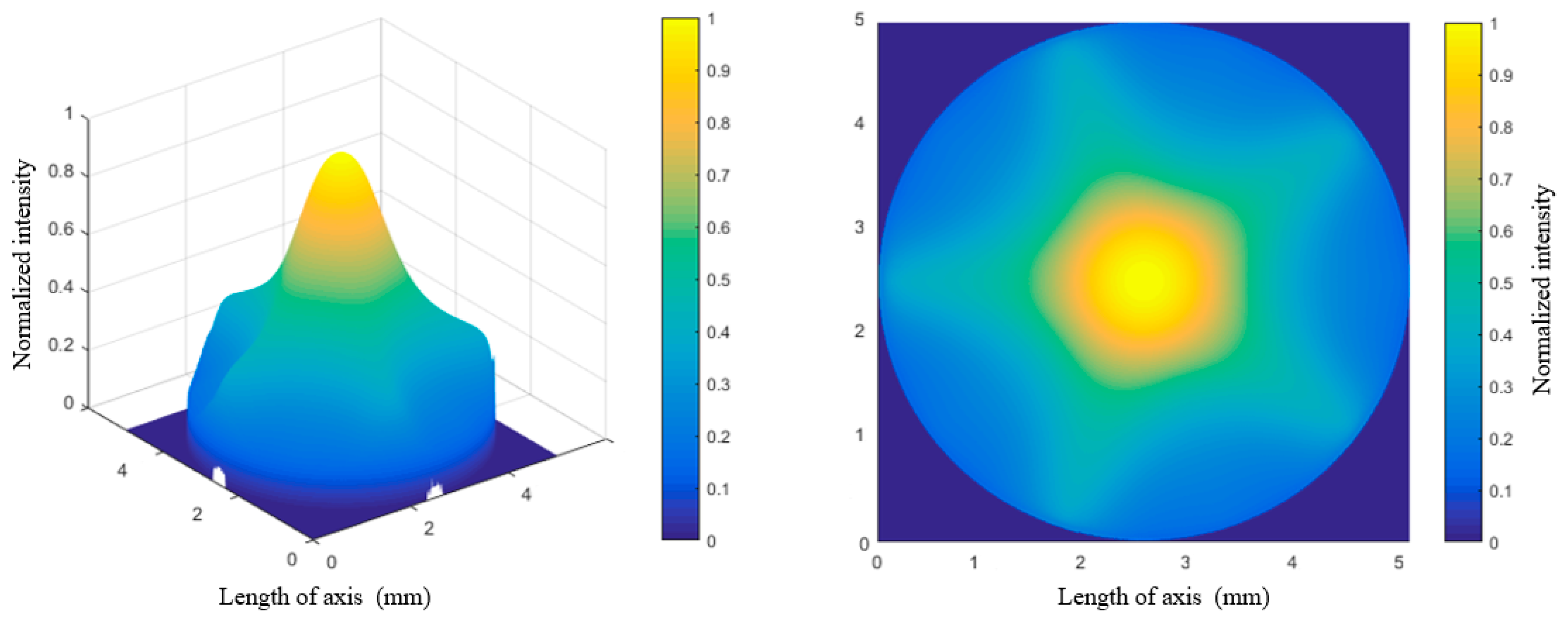

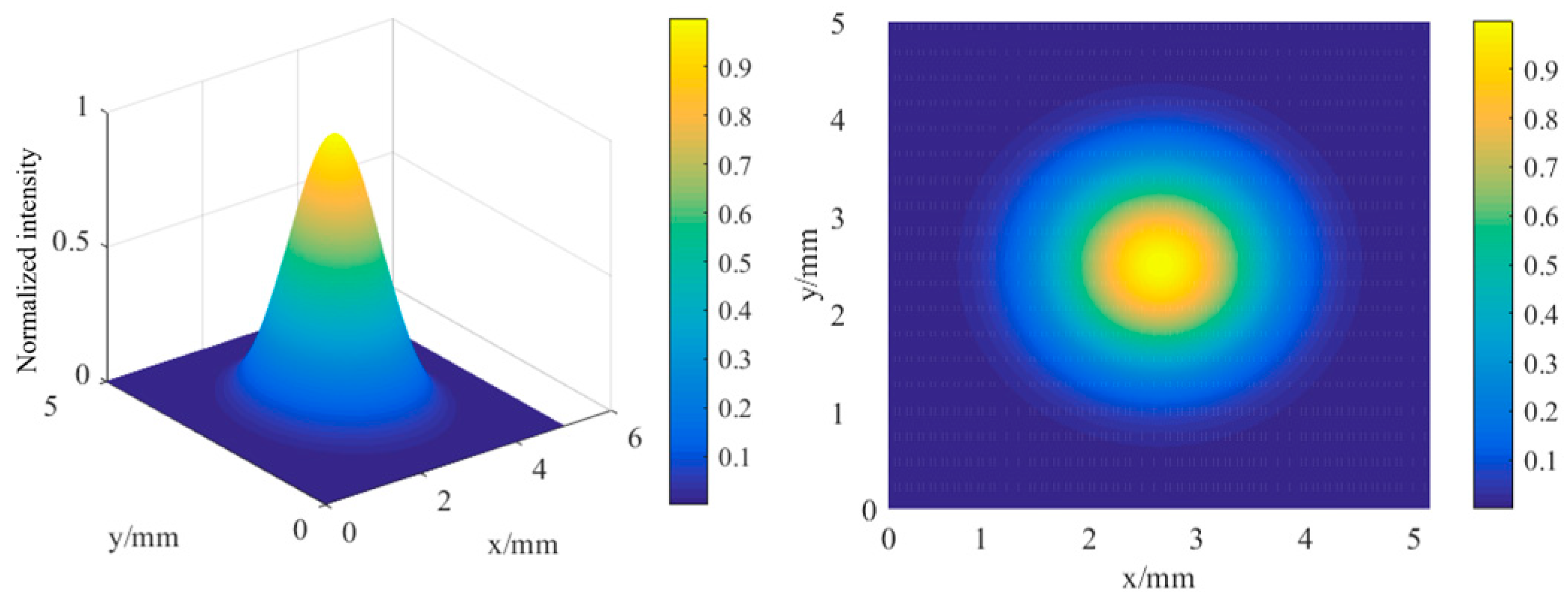

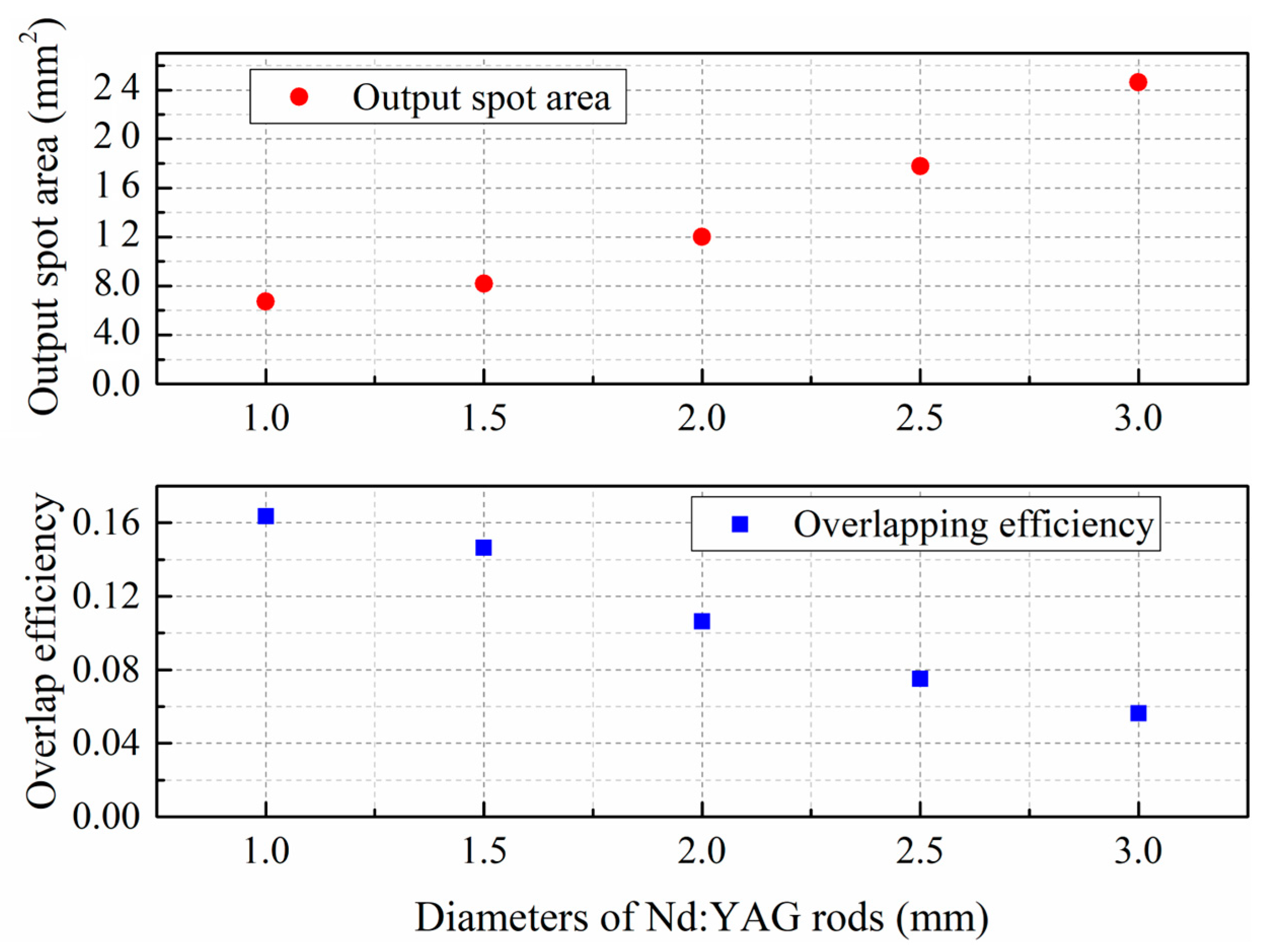
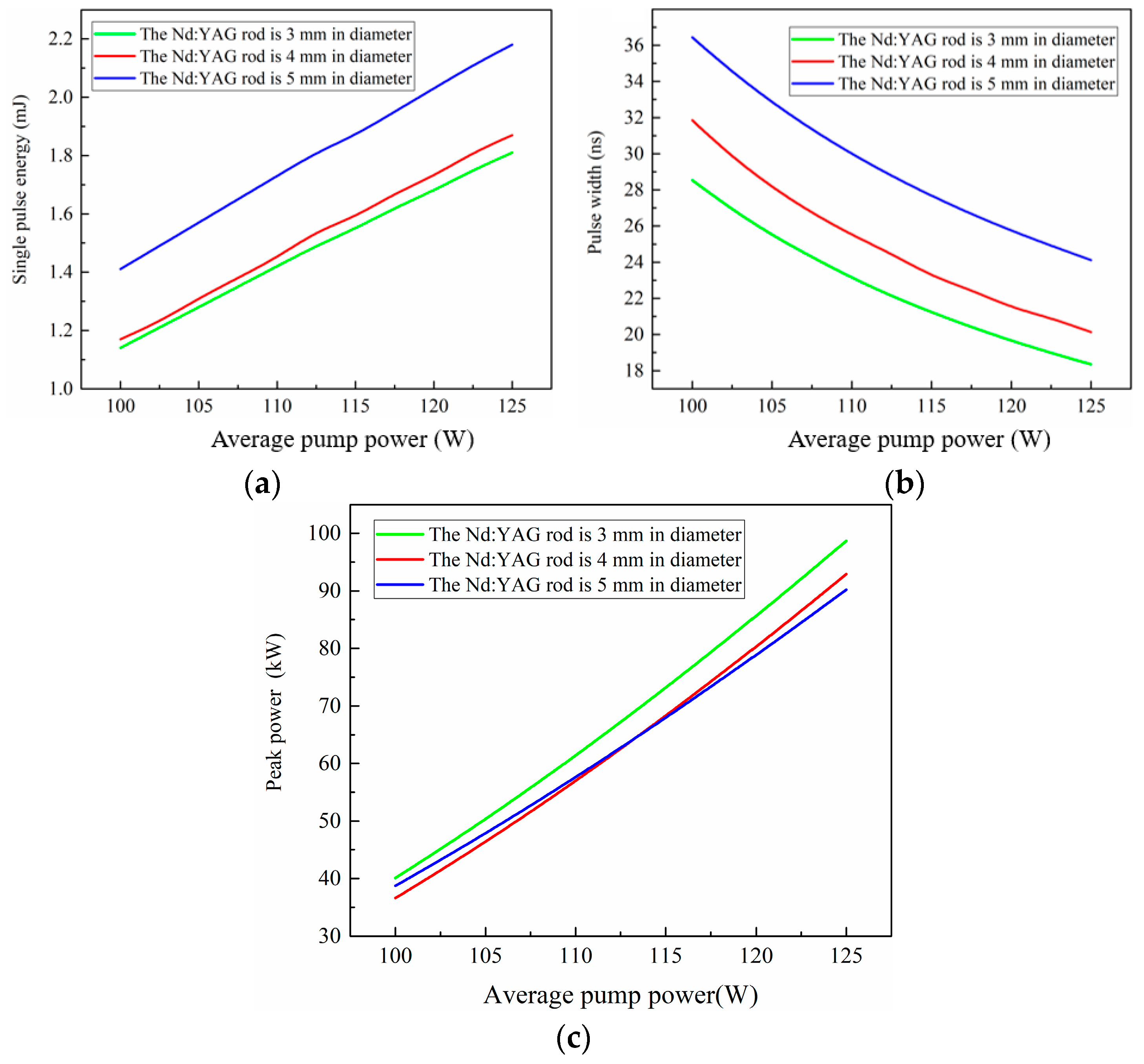
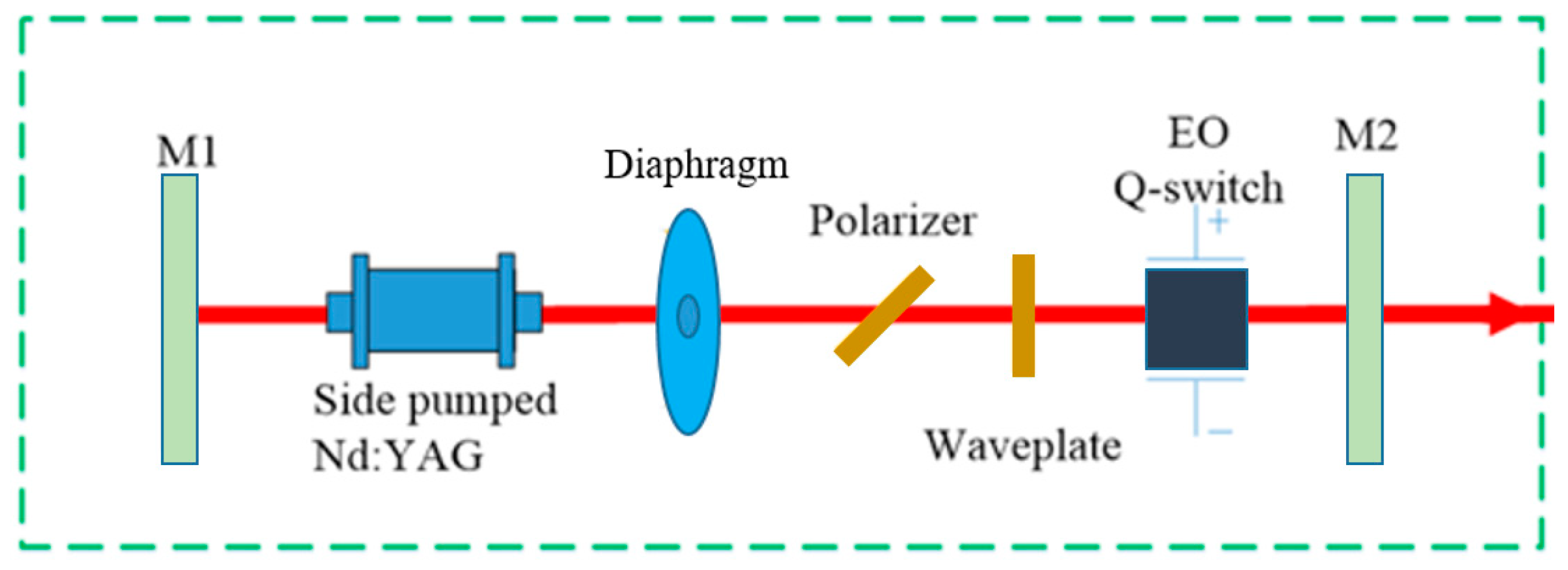

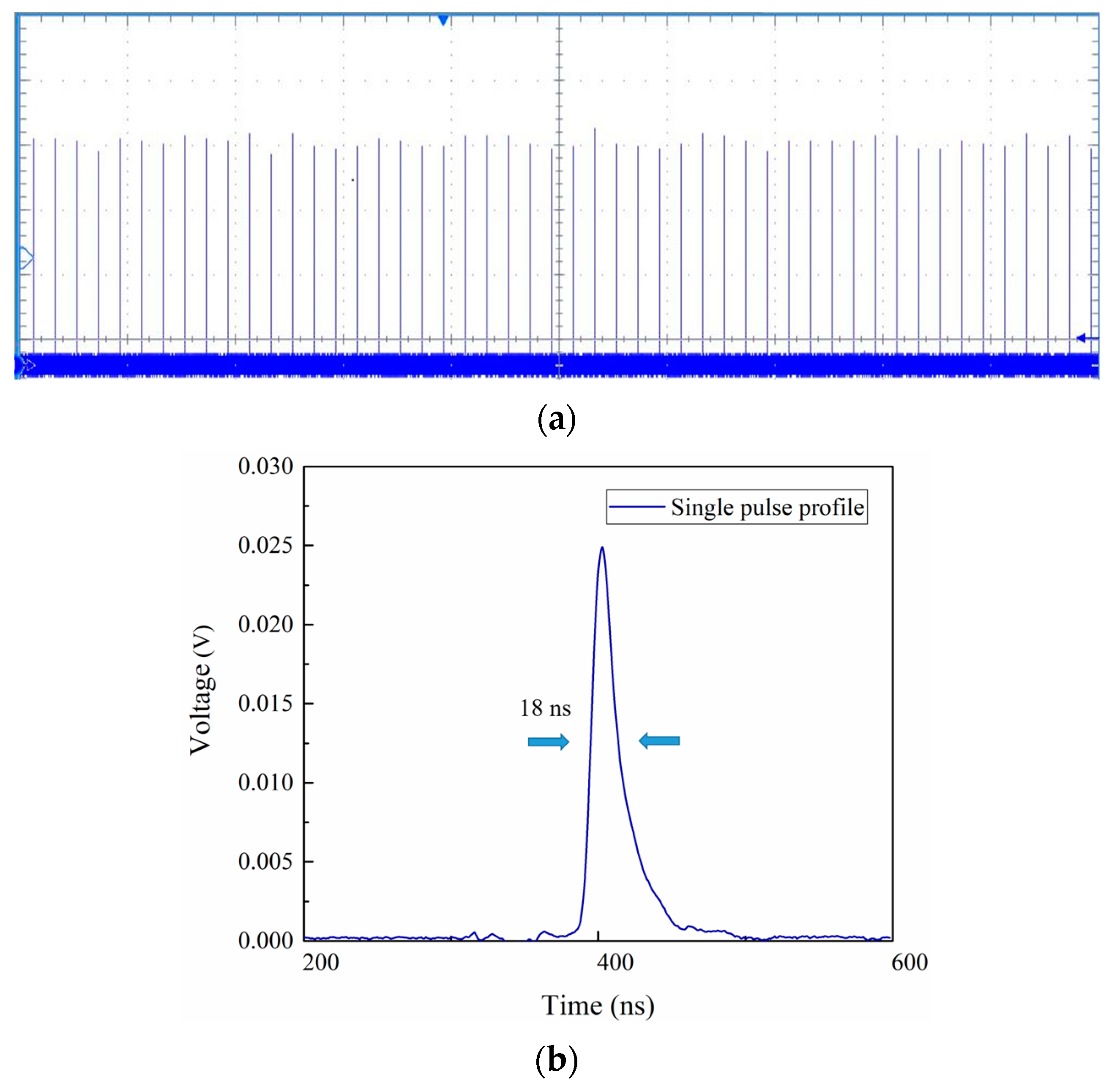

| Parameters | Numerical Values |
|---|---|
| Number of pumping directions | 5 |
| Distance between LD bars and gain medium center | 6.1 mm |
| Manufacturer of LD bars | Coherent Inc. |
| LD bar model | 100 W 50 FF × 2 mm TE |
| Fast axis divergence of LD bars (1/e2) | ~50° |
| The refractive index of the gain medium | 1.82 |
| The refractive index of the cooling liquid | 1.33 |
| The refractive index of the flow tube | 1.45 |
| The inner diameter of the flow tube | 5.9 mm |
| The wall thickness of the flow tube | 1.67 mm |
| Effective pumping length | ~50 mm |
| Rated centroid pumping wavelength | 808 nm |
| Laser medium | Nd:YAG |
| The doping concentration of the laser medium | 0.6 at.% |
| Diameter of the medium gain rod | 3 mm, 4 mm, 5 mm, 6 mm |
| Gain medium-side surface diffusion (divergence) | ~15° |
Disclaimer/Publisher’s Note: The statements, opinions and data contained in all publications are solely those of the individual author(s) and contributor(s) and not of MDPI and/or the editor(s). MDPI and/or the editor(s) disclaim responsibility for any injury to people or property resulting from any ideas, methods, instructions or products referred to in the content. |
© 2023 by the authors. Licensee MDPI, Basel, Switzerland. This article is an open access article distributed under the terms and conditions of the Creative Commons Attribution (CC BY) license (https://creativecommons.org/licenses/by/4.0/).
Share and Cite
Yan, R.; Xu, H.; Li, X. Computation and Verification of Spatial Rate Equations for an Electro-Optically Q-Switched Laser-Diode Side-Pumped Nd:YAG Laser. Appl. Sci. 2023, 13, 5410. https://doi.org/10.3390/app13095410
Yan R, Xu H, Li X. Computation and Verification of Spatial Rate Equations for an Electro-Optically Q-Switched Laser-Diode Side-Pumped Nd:YAG Laser. Applied Sciences. 2023; 13(9):5410. https://doi.org/10.3390/app13095410
Chicago/Turabian StyleYan, Renpeng, Haobo Xu, and Xudong Li. 2023. "Computation and Verification of Spatial Rate Equations for an Electro-Optically Q-Switched Laser-Diode Side-Pumped Nd:YAG Laser" Applied Sciences 13, no. 9: 5410. https://doi.org/10.3390/app13095410
APA StyleYan, R., Xu, H., & Li, X. (2023). Computation and Verification of Spatial Rate Equations for an Electro-Optically Q-Switched Laser-Diode Side-Pumped Nd:YAG Laser. Applied Sciences, 13(9), 5410. https://doi.org/10.3390/app13095410







